Financial Management Report: Stortford Yachts Ltd Financial Analysis
VerifiedAdded on 2020/06/06
|11
|3224
|148
Report
AI Summary
This report provides a comprehensive analysis of financial management, focusing on the differences between financial and management accounts and their respective purposes. It details the significance of financial information for various stakeholders, including shareholders, buyers, and financial institutions. The report includes an analysis of Stortford Yachts Ltd's financial performance using ratio analysis to assess profitability and liquidity. It also compares profit and non-profit organizations' financial statements and explores the roles of different stakeholders and their crucial data in business decision-making. The report covers income statements, statements of financial position, and cash flow statements, offering a detailed overview of financial reporting and its importance in organizational success. The report is a valuable resource for students studying financial management, providing insights into key concepts and practical applications.
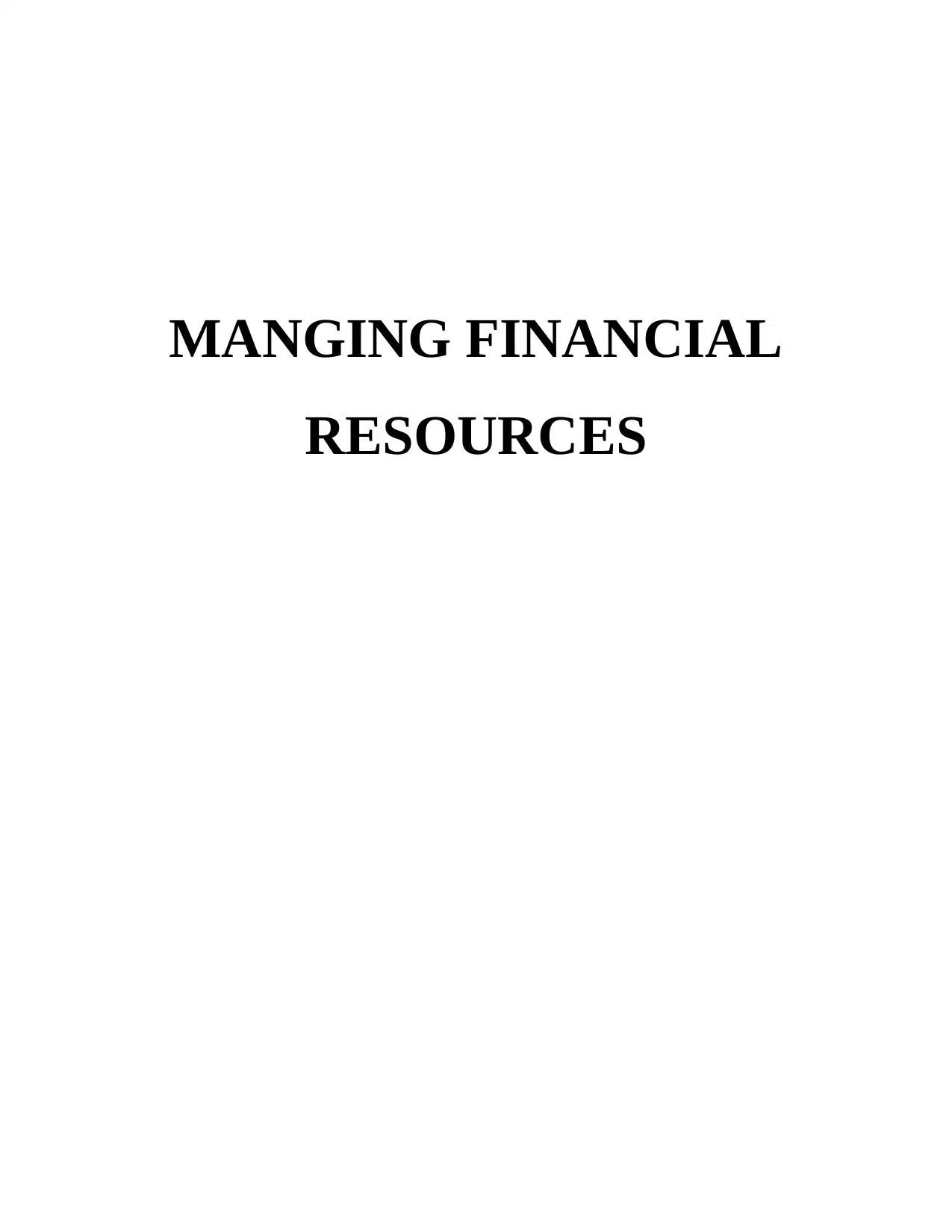
MANGING FINANCIAL
RESOURCES
RESOURCES
Paraphrase This Document
Need a fresh take? Get an instant paraphrase of this document with our AI Paraphraser
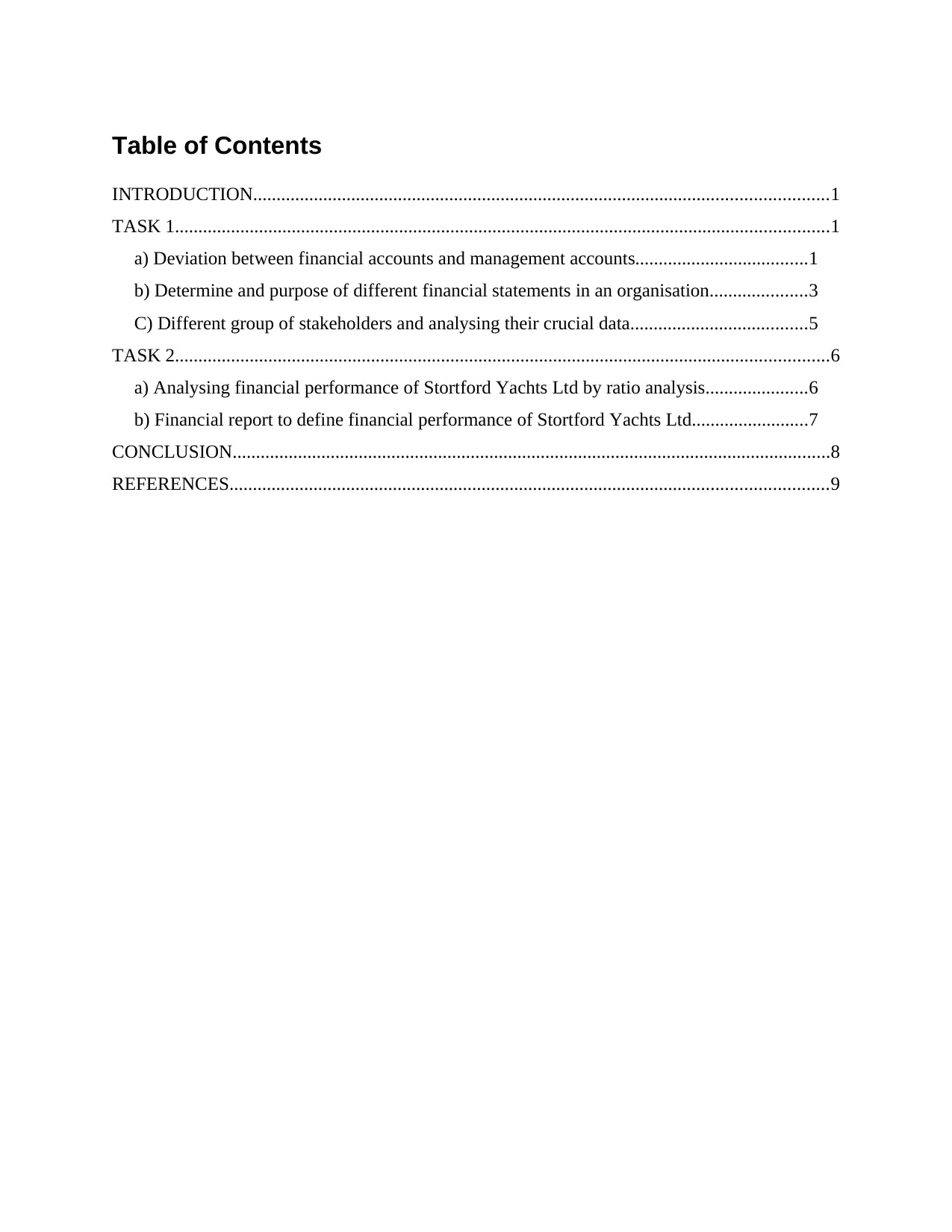
Table of Contents
INTRODUCTION...........................................................................................................................1
TASK 1............................................................................................................................................1
a) Deviation between financial accounts and management accounts.....................................1
b) Determine and purpose of different financial statements in an organisation.....................3
C) Different group of stakeholders and analysing their crucial data......................................5
TASK 2............................................................................................................................................6
a) Analysing financial performance of Stortford Yachts Ltd by ratio analysis......................6
b) Financial report to define financial performance of Stortford Yachts Ltd.........................7
CONCLUSION................................................................................................................................8
REFERENCES................................................................................................................................9
INTRODUCTION...........................................................................................................................1
TASK 1............................................................................................................................................1
a) Deviation between financial accounts and management accounts.....................................1
b) Determine and purpose of different financial statements in an organisation.....................3
C) Different group of stakeholders and analysing their crucial data......................................5
TASK 2............................................................................................................................................6
a) Analysing financial performance of Stortford Yachts Ltd by ratio analysis......................6
b) Financial report to define financial performance of Stortford Yachts Ltd.........................7
CONCLUSION................................................................................................................................8
REFERENCES................................................................................................................................9
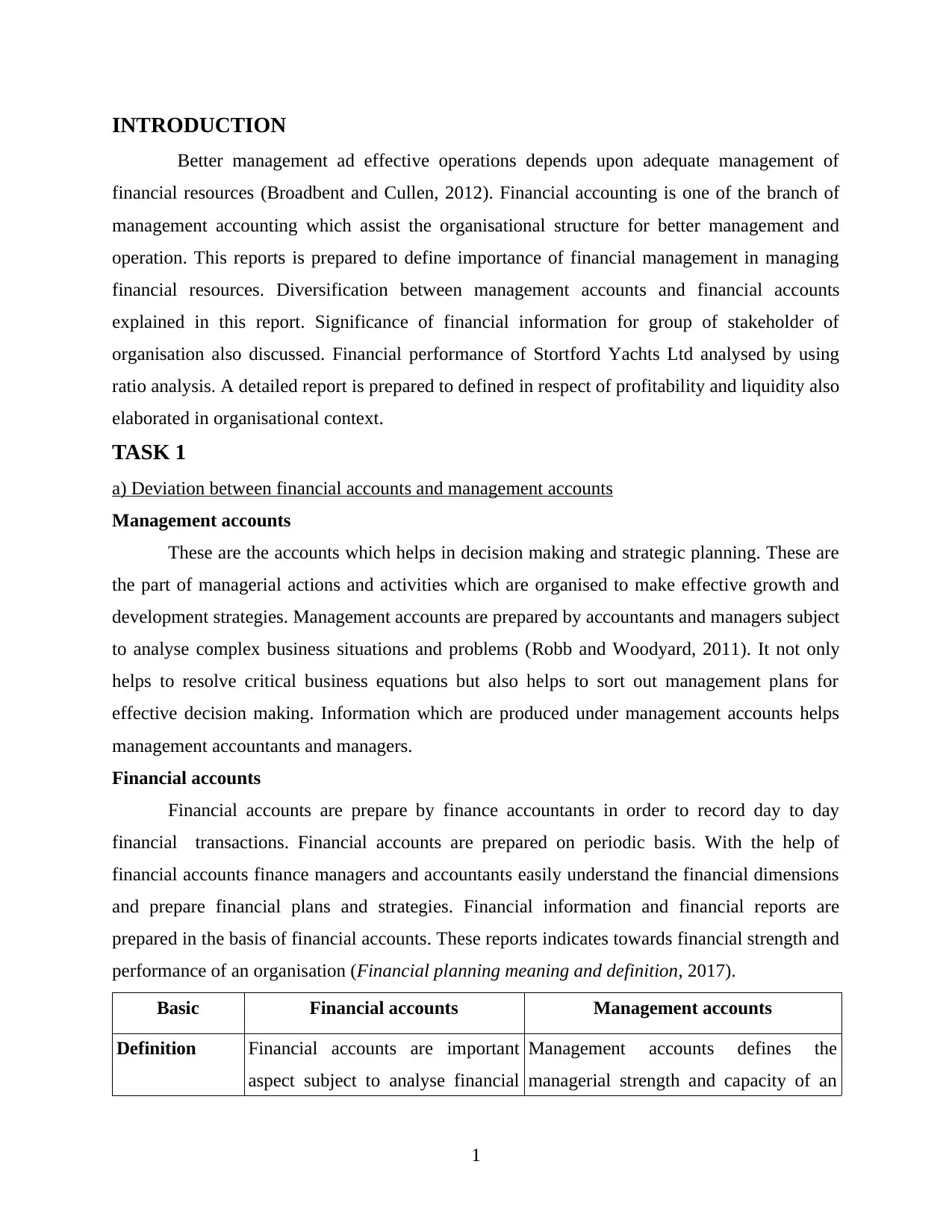
INTRODUCTION
Better management ad effective operations depends upon adequate management of
financial resources (Broadbent and Cullen, 2012). Financial accounting is one of the branch of
management accounting which assist the organisational structure for better management and
operation. This reports is prepared to define importance of financial management in managing
financial resources. Diversification between management accounts and financial accounts
explained in this report. Significance of financial information for group of stakeholder of
organisation also discussed. Financial performance of Stortford Yachts Ltd analysed by using
ratio analysis. A detailed report is prepared to defined in respect of profitability and liquidity also
elaborated in organisational context.
TASK 1
a) Deviation between financial accounts and management accounts
Management accounts
These are the accounts which helps in decision making and strategic planning. These are
the part of managerial actions and activities which are organised to make effective growth and
development strategies. Management accounts are prepared by accountants and managers subject
to analyse complex business situations and problems (Robb and Woodyard, 2011). It not only
helps to resolve critical business equations but also helps to sort out management plans for
effective decision making. Information which are produced under management accounts helps
management accountants and managers.
Financial accounts
Financial accounts are prepare by finance accountants in order to record day to day
financial transactions. Financial accounts are prepared on periodic basis. With the help of
financial accounts finance managers and accountants easily understand the financial dimensions
and prepare financial plans and strategies. Financial information and financial reports are
prepared in the basis of financial accounts. These reports indicates towards financial strength and
performance of an organisation (Financial planning meaning and definition, 2017).
Basic Financial accounts Management accounts
Definition Financial accounts are important
aspect subject to analyse financial
Management accounts defines the
managerial strength and capacity of an
1
Better management ad effective operations depends upon adequate management of
financial resources (Broadbent and Cullen, 2012). Financial accounting is one of the branch of
management accounting which assist the organisational structure for better management and
operation. This reports is prepared to define importance of financial management in managing
financial resources. Diversification between management accounts and financial accounts
explained in this report. Significance of financial information for group of stakeholder of
organisation also discussed. Financial performance of Stortford Yachts Ltd analysed by using
ratio analysis. A detailed report is prepared to defined in respect of profitability and liquidity also
elaborated in organisational context.
TASK 1
a) Deviation between financial accounts and management accounts
Management accounts
These are the accounts which helps in decision making and strategic planning. These are
the part of managerial actions and activities which are organised to make effective growth and
development strategies. Management accounts are prepared by accountants and managers subject
to analyse complex business situations and problems (Robb and Woodyard, 2011). It not only
helps to resolve critical business equations but also helps to sort out management plans for
effective decision making. Information which are produced under management accounts helps
management accountants and managers.
Financial accounts
Financial accounts are prepare by finance accountants in order to record day to day
financial transactions. Financial accounts are prepared on periodic basis. With the help of
financial accounts finance managers and accountants easily understand the financial dimensions
and prepare financial plans and strategies. Financial information and financial reports are
prepared in the basis of financial accounts. These reports indicates towards financial strength and
performance of an organisation (Financial planning meaning and definition, 2017).
Basic Financial accounts Management accounts
Definition Financial accounts are important
aspect subject to analyse financial
Management accounts defines the
managerial strength and capacity of an
1
⊘ This is a preview!⊘
Do you want full access?
Subscribe today to unlock all pages.

Trusted by 1+ million students worldwide
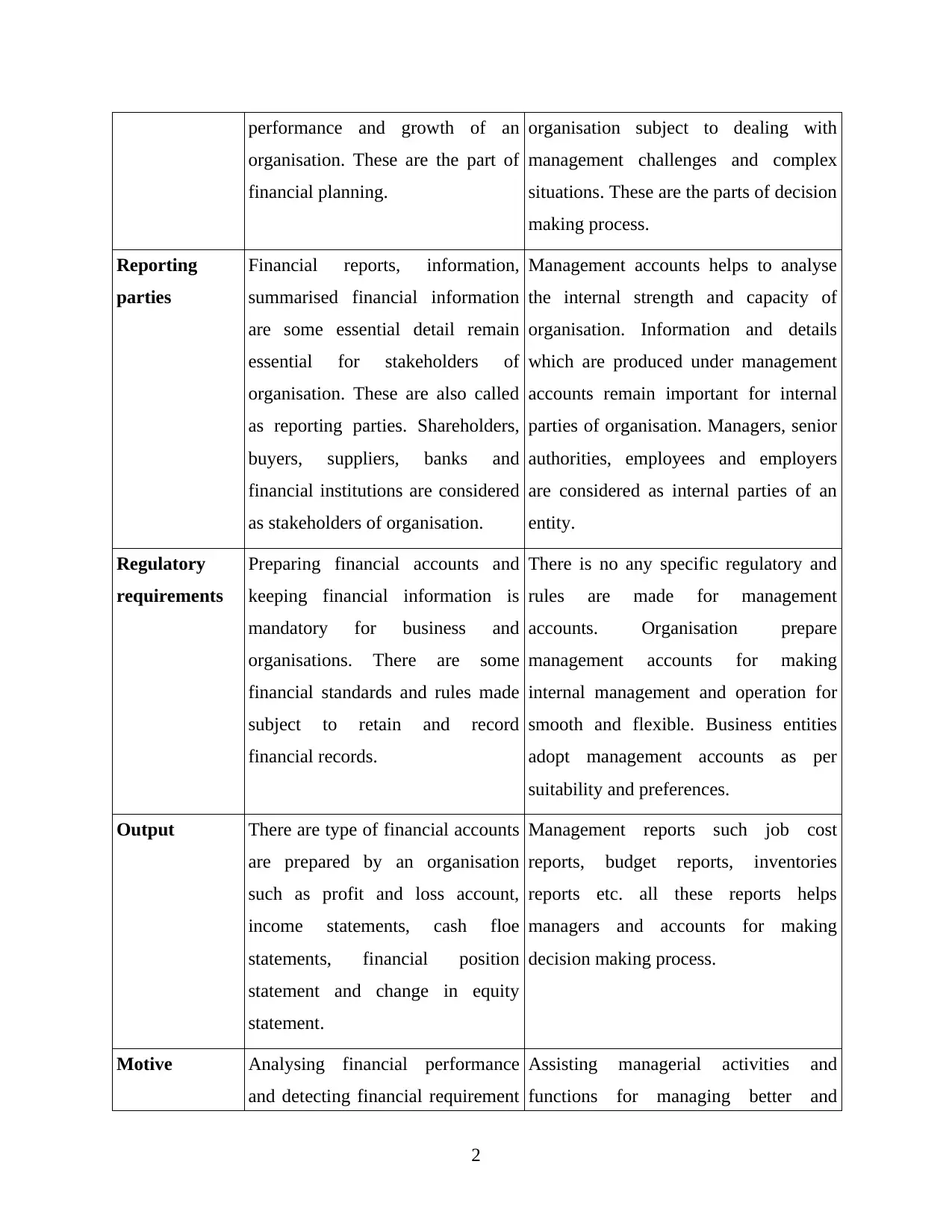
performance and growth of an
organisation. These are the part of
financial planning.
organisation subject to dealing with
management challenges and complex
situations. These are the parts of decision
making process.
Reporting
parties
Financial reports, information,
summarised financial information
are some essential detail remain
essential for stakeholders of
organisation. These are also called
as reporting parties. Shareholders,
buyers, suppliers, banks and
financial institutions are considered
as stakeholders of organisation.
Management accounts helps to analyse
the internal strength and capacity of
organisation. Information and details
which are produced under management
accounts remain important for internal
parties of organisation. Managers, senior
authorities, employees and employers
are considered as internal parties of an
entity.
Regulatory
requirements
Preparing financial accounts and
keeping financial information is
mandatory for business and
organisations. There are some
financial standards and rules made
subject to retain and record
financial records.
There is no any specific regulatory and
rules are made for management
accounts. Organisation prepare
management accounts for making
internal management and operation for
smooth and flexible. Business entities
adopt management accounts as per
suitability and preferences.
Output There are type of financial accounts
are prepared by an organisation
such as profit and loss account,
income statements, cash floe
statements, financial position
statement and change in equity
statement.
Management reports such job cost
reports, budget reports, inventories
reports etc. all these reports helps
managers and accounts for making
decision making process.
Motive Analysing financial performance
and detecting financial requirement
Assisting managerial activities and
functions for managing better and
2
organisation. These are the part of
financial planning.
organisation subject to dealing with
management challenges and complex
situations. These are the parts of decision
making process.
Reporting
parties
Financial reports, information,
summarised financial information
are some essential detail remain
essential for stakeholders of
organisation. These are also called
as reporting parties. Shareholders,
buyers, suppliers, banks and
financial institutions are considered
as stakeholders of organisation.
Management accounts helps to analyse
the internal strength and capacity of
organisation. Information and details
which are produced under management
accounts remain important for internal
parties of organisation. Managers, senior
authorities, employees and employers
are considered as internal parties of an
entity.
Regulatory
requirements
Preparing financial accounts and
keeping financial information is
mandatory for business and
organisations. There are some
financial standards and rules made
subject to retain and record
financial records.
There is no any specific regulatory and
rules are made for management
accounts. Organisation prepare
management accounts for making
internal management and operation for
smooth and flexible. Business entities
adopt management accounts as per
suitability and preferences.
Output There are type of financial accounts
are prepared by an organisation
such as profit and loss account,
income statements, cash floe
statements, financial position
statement and change in equity
statement.
Management reports such job cost
reports, budget reports, inventories
reports etc. all these reports helps
managers and accounts for making
decision making process.
Motive Analysing financial performance
and detecting financial requirement
Assisting managerial activities and
functions for managing better and
2
Paraphrase This Document
Need a fresh take? Get an instant paraphrase of this document with our AI Paraphraser
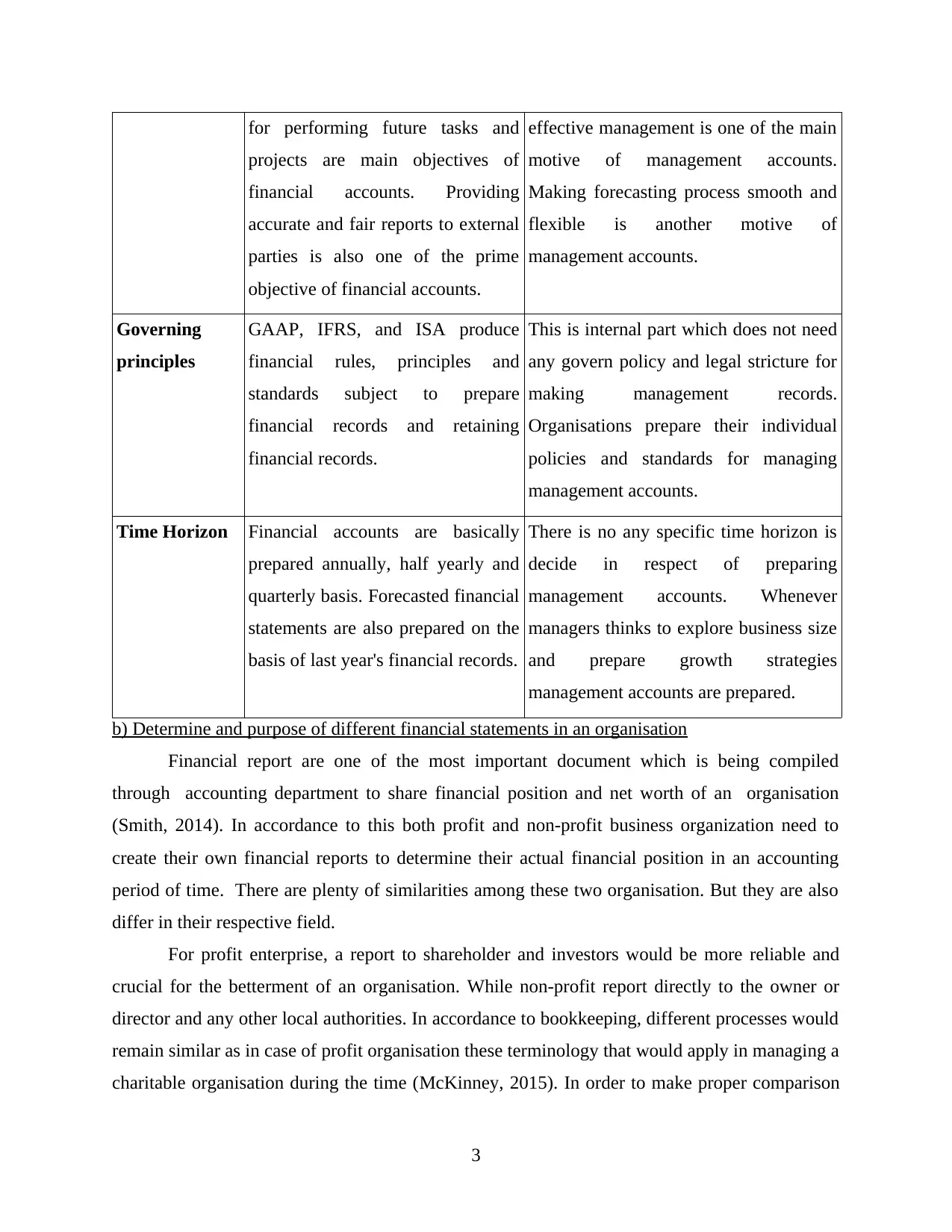
for performing future tasks and
projects are main objectives of
financial accounts. Providing
accurate and fair reports to external
parties is also one of the prime
objective of financial accounts.
effective management is one of the main
motive of management accounts.
Making forecasting process smooth and
flexible is another motive of
management accounts.
Governing
principles
GAAP, IFRS, and ISA produce
financial rules, principles and
standards subject to prepare
financial records and retaining
financial records.
This is internal part which does not need
any govern policy and legal stricture for
making management records.
Organisations prepare their individual
policies and standards for managing
management accounts.
Time Horizon Financial accounts are basically
prepared annually, half yearly and
quarterly basis. Forecasted financial
statements are also prepared on the
basis of last year's financial records.
There is no any specific time horizon is
decide in respect of preparing
management accounts. Whenever
managers thinks to explore business size
and prepare growth strategies
management accounts are prepared.
b) Determine and purpose of different financial statements in an organisation
Financial report are one of the most important document which is being compiled
through accounting department to share financial position and net worth of an organisation
(Smith, 2014). In accordance to this both profit and non-profit business organization need to
create their own financial reports to determine their actual financial position in an accounting
period of time. There are plenty of similarities among these two organisation. But they are also
differ in their respective field.
For profit enterprise, a report to shareholder and investors would be more reliable and
crucial for the betterment of an organisation. While non-profit report directly to the owner or
director and any other local authorities. In accordance to bookkeeping, different processes would
remain similar as in case of profit organisation these terminology that would apply in managing a
charitable organisation during the time (McKinney, 2015). In order to make proper comparison
3
projects are main objectives of
financial accounts. Providing
accurate and fair reports to external
parties is also one of the prime
objective of financial accounts.
effective management is one of the main
motive of management accounts.
Making forecasting process smooth and
flexible is another motive of
management accounts.
Governing
principles
GAAP, IFRS, and ISA produce
financial rules, principles and
standards subject to prepare
financial records and retaining
financial records.
This is internal part which does not need
any govern policy and legal stricture for
making management records.
Organisations prepare their individual
policies and standards for managing
management accounts.
Time Horizon Financial accounts are basically
prepared annually, half yearly and
quarterly basis. Forecasted financial
statements are also prepared on the
basis of last year's financial records.
There is no any specific time horizon is
decide in respect of preparing
management accounts. Whenever
managers thinks to explore business size
and prepare growth strategies
management accounts are prepared.
b) Determine and purpose of different financial statements in an organisation
Financial report are one of the most important document which is being compiled
through accounting department to share financial position and net worth of an organisation
(Smith, 2014). In accordance to this both profit and non-profit business organization need to
create their own financial reports to determine their actual financial position in an accounting
period of time. There are plenty of similarities among these two organisation. But they are also
differ in their respective field.
For profit enterprise, a report to shareholder and investors would be more reliable and
crucial for the betterment of an organisation. While non-profit report directly to the owner or
director and any other local authorities. In accordance to bookkeeping, different processes would
remain similar as in case of profit organisation these terminology that would apply in managing a
charitable organisation during the time (McKinney, 2015). In order to make proper comparison
3
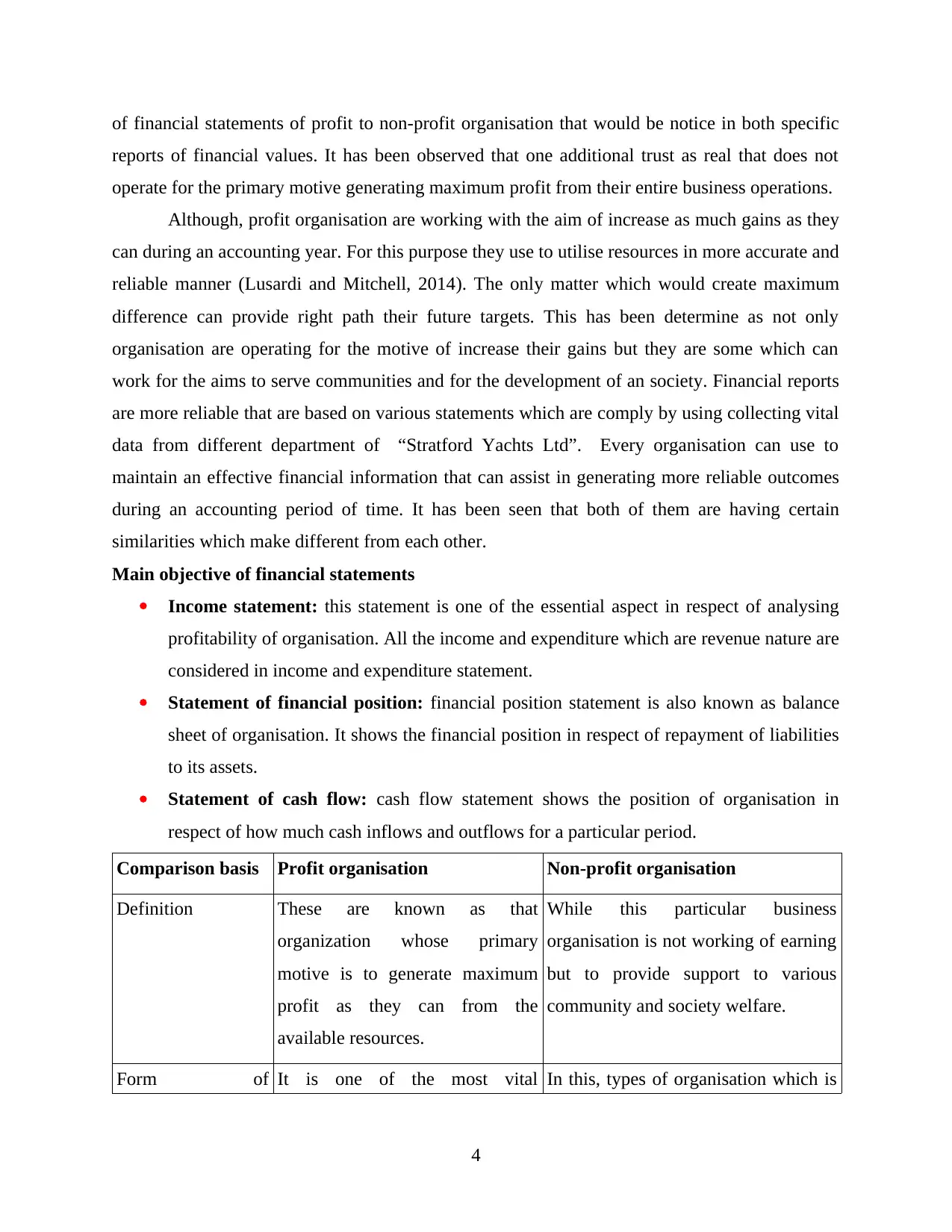
of financial statements of profit to non-profit organisation that would be notice in both specific
reports of financial values. It has been observed that one additional trust as real that does not
operate for the primary motive generating maximum profit from their entire business operations.
Although, profit organisation are working with the aim of increase as much gains as they
can during an accounting year. For this purpose they use to utilise resources in more accurate and
reliable manner (Lusardi and Mitchell, 2014). The only matter which would create maximum
difference can provide right path their future targets. This has been determine as not only
organisation are operating for the motive of increase their gains but they are some which can
work for the aims to serve communities and for the development of an society. Financial reports
are more reliable that are based on various statements which are comply by using collecting vital
data from different department of “Stratford Yachts Ltd”. Every organisation can use to
maintain an effective financial information that can assist in generating more reliable outcomes
during an accounting period of time. It has been seen that both of them are having certain
similarities which make different from each other.
Main objective of financial statements
Income statement: this statement is one of the essential aspect in respect of analysing
profitability of organisation. All the income and expenditure which are revenue nature are
considered in income and expenditure statement.
Statement of financial position: financial position statement is also known as balance
sheet of organisation. It shows the financial position in respect of repayment of liabilities
to its assets.
Statement of cash flow: cash flow statement shows the position of organisation in
respect of how much cash inflows and outflows for a particular period.
Comparison basis Profit organisation Non-profit organisation
Definition These are known as that
organization whose primary
motive is to generate maximum
profit as they can from the
available resources.
While this particular business
organisation is not working of earning
but to provide support to various
community and society welfare.
Form of It is one of the most vital In this, types of organisation which is
4
reports of financial values. It has been observed that one additional trust as real that does not
operate for the primary motive generating maximum profit from their entire business operations.
Although, profit organisation are working with the aim of increase as much gains as they
can during an accounting year. For this purpose they use to utilise resources in more accurate and
reliable manner (Lusardi and Mitchell, 2014). The only matter which would create maximum
difference can provide right path their future targets. This has been determine as not only
organisation are operating for the motive of increase their gains but they are some which can
work for the aims to serve communities and for the development of an society. Financial reports
are more reliable that are based on various statements which are comply by using collecting vital
data from different department of “Stratford Yachts Ltd”. Every organisation can use to
maintain an effective financial information that can assist in generating more reliable outcomes
during an accounting period of time. It has been seen that both of them are having certain
similarities which make different from each other.
Main objective of financial statements
Income statement: this statement is one of the essential aspect in respect of analysing
profitability of organisation. All the income and expenditure which are revenue nature are
considered in income and expenditure statement.
Statement of financial position: financial position statement is also known as balance
sheet of organisation. It shows the financial position in respect of repayment of liabilities
to its assets.
Statement of cash flow: cash flow statement shows the position of organisation in
respect of how much cash inflows and outflows for a particular period.
Comparison basis Profit organisation Non-profit organisation
Definition These are known as that
organization whose primary
motive is to generate maximum
profit as they can from the
available resources.
While this particular business
organisation is not working of earning
but to provide support to various
community and society welfare.
Form of It is one of the most vital In this, types of organisation which is
4
⊘ This is a preview!⊘
Do you want full access?
Subscribe today to unlock all pages.

Trusted by 1+ million students worldwide
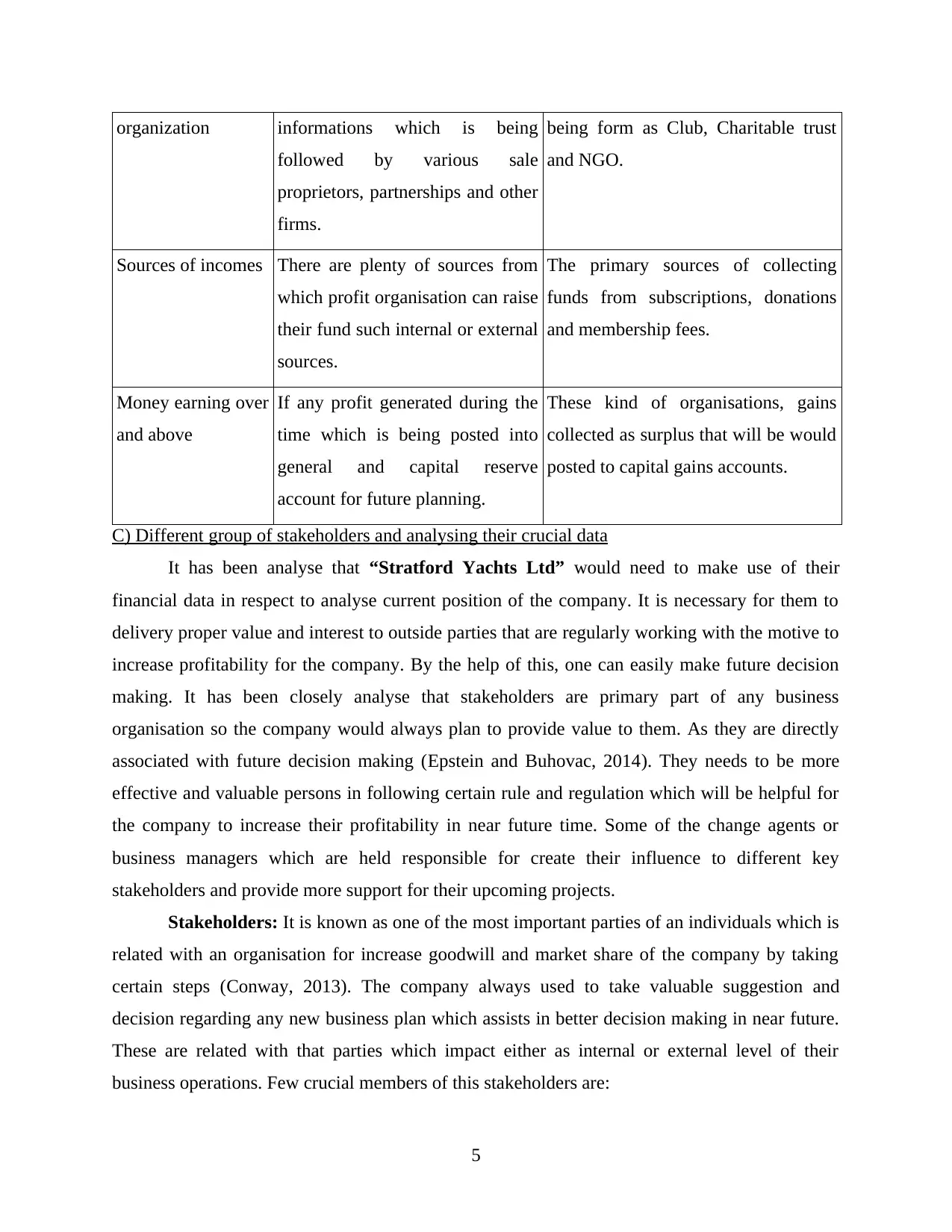
organization informations which is being
followed by various sale
proprietors, partnerships and other
firms.
being form as Club, Charitable trust
and NGO.
Sources of incomes There are plenty of sources from
which profit organisation can raise
their fund such internal or external
sources.
The primary sources of collecting
funds from subscriptions, donations
and membership fees.
Money earning over
and above
If any profit generated during the
time which is being posted into
general and capital reserve
account for future planning.
These kind of organisations, gains
collected as surplus that will be would
posted to capital gains accounts.
C) Different group of stakeholders and analysing their crucial data
It has been analyse that “Stratford Yachts Ltd” would need to make use of their
financial data in respect to analyse current position of the company. It is necessary for them to
delivery proper value and interest to outside parties that are regularly working with the motive to
increase profitability for the company. By the help of this, one can easily make future decision
making. It has been closely analyse that stakeholders are primary part of any business
organisation so the company would always plan to provide value to them. As they are directly
associated with future decision making (Epstein and Buhovac, 2014). They needs to be more
effective and valuable persons in following certain rule and regulation which will be helpful for
the company to increase their profitability in near future time. Some of the change agents or
business managers which are held responsible for create their influence to different key
stakeholders and provide more support for their upcoming projects.
Stakeholders: It is known as one of the most important parties of an individuals which is
related with an organisation for increase goodwill and market share of the company by taking
certain steps (Conway, 2013). The company always used to take valuable suggestion and
decision regarding any new business plan which assists in better decision making in near future.
These are related with that parties which impact either as internal or external level of their
business operations. Few crucial members of this stakeholders are:
5
followed by various sale
proprietors, partnerships and other
firms.
being form as Club, Charitable trust
and NGO.
Sources of incomes There are plenty of sources from
which profit organisation can raise
their fund such internal or external
sources.
The primary sources of collecting
funds from subscriptions, donations
and membership fees.
Money earning over
and above
If any profit generated during the
time which is being posted into
general and capital reserve
account for future planning.
These kind of organisations, gains
collected as surplus that will be would
posted to capital gains accounts.
C) Different group of stakeholders and analysing their crucial data
It has been analyse that “Stratford Yachts Ltd” would need to make use of their
financial data in respect to analyse current position of the company. It is necessary for them to
delivery proper value and interest to outside parties that are regularly working with the motive to
increase profitability for the company. By the help of this, one can easily make future decision
making. It has been closely analyse that stakeholders are primary part of any business
organisation so the company would always plan to provide value to them. As they are directly
associated with future decision making (Epstein and Buhovac, 2014). They needs to be more
effective and valuable persons in following certain rule and regulation which will be helpful for
the company to increase their profitability in near future time. Some of the change agents or
business managers which are held responsible for create their influence to different key
stakeholders and provide more support for their upcoming projects.
Stakeholders: It is known as one of the most important parties of an individuals which is
related with an organisation for increase goodwill and market share of the company by taking
certain steps (Conway, 2013). The company always used to take valuable suggestion and
decision regarding any new business plan which assists in better decision making in near future.
These are related with that parties which impact either as internal or external level of their
business operations. Few crucial members of this stakeholders are:
5
Paraphrase This Document
Need a fresh take? Get an instant paraphrase of this document with our AI Paraphraser
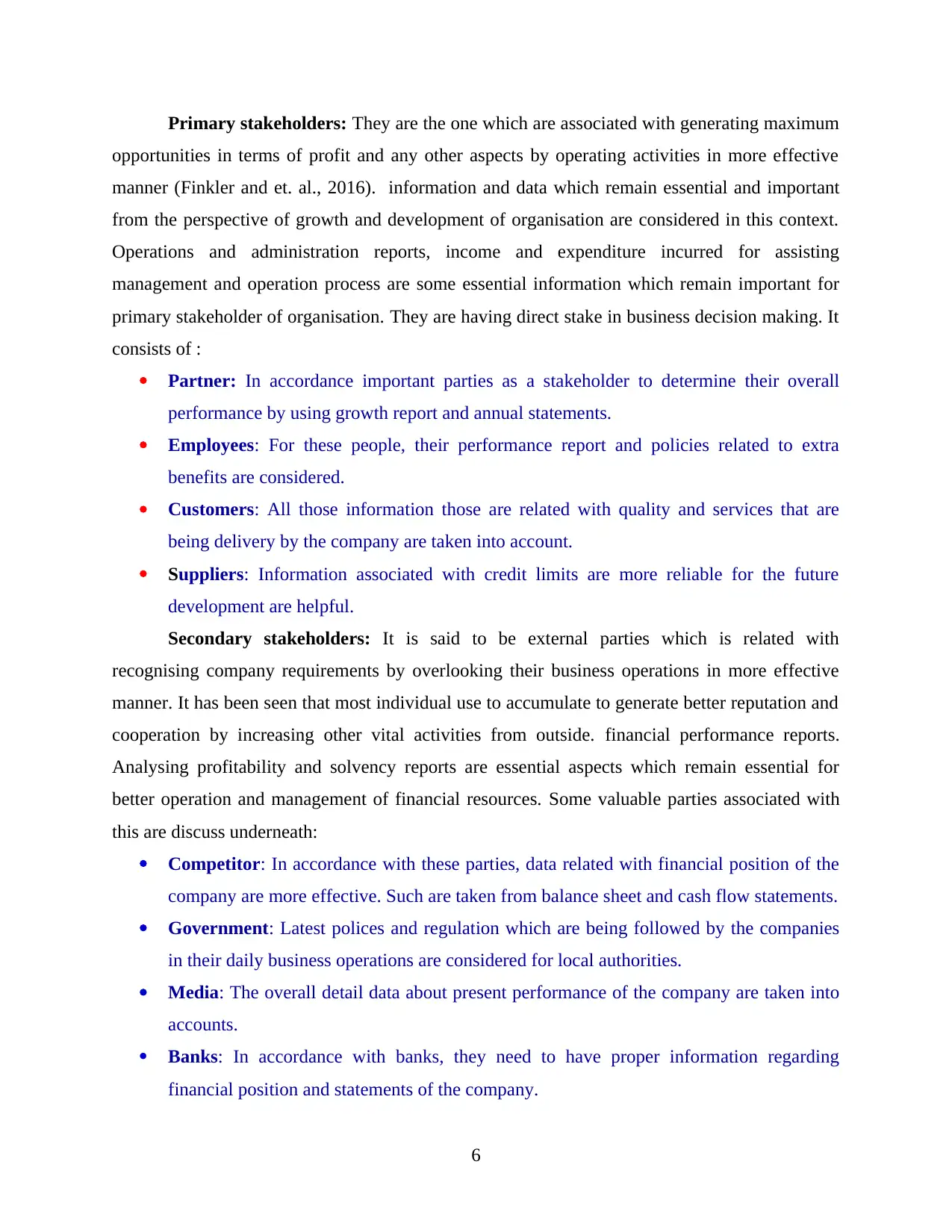
Primary stakeholders: They are the one which are associated with generating maximum
opportunities in terms of profit and any other aspects by operating activities in more effective
manner (Finkler and et. al., 2016). information and data which remain essential and important
from the perspective of growth and development of organisation are considered in this context.
Operations and administration reports, income and expenditure incurred for assisting
management and operation process are some essential information which remain important for
primary stakeholder of organisation. They are having direct stake in business decision making. It
consists of :
Partner: In accordance important parties as a stakeholder to determine their overall
performance by using growth report and annual statements.
Employees: For these people, their performance report and policies related to extra
benefits are considered.
Customers: All those information those are related with quality and services that are
being delivery by the company are taken into account.
Suppliers: Information associated with credit limits are more reliable for the future
development are helpful.
Secondary stakeholders: It is said to be external parties which is related with
recognising company requirements by overlooking their business operations in more effective
manner. It has been seen that most individual use to accumulate to generate better reputation and
cooperation by increasing other vital activities from outside. financial performance reports.
Analysing profitability and solvency reports are essential aspects which remain essential for
better operation and management of financial resources. Some valuable parties associated with
this are discuss underneath:
Competitor: In accordance with these parties, data related with financial position of the
company are more effective. Such are taken from balance sheet and cash flow statements.
Government: Latest polices and regulation which are being followed by the companies
in their daily business operations are considered for local authorities.
Media: The overall detail data about present performance of the company are taken into
accounts.
Banks: In accordance with banks, they need to have proper information regarding
financial position and statements of the company.
6
opportunities in terms of profit and any other aspects by operating activities in more effective
manner (Finkler and et. al., 2016). information and data which remain essential and important
from the perspective of growth and development of organisation are considered in this context.
Operations and administration reports, income and expenditure incurred for assisting
management and operation process are some essential information which remain important for
primary stakeholder of organisation. They are having direct stake in business decision making. It
consists of :
Partner: In accordance important parties as a stakeholder to determine their overall
performance by using growth report and annual statements.
Employees: For these people, their performance report and policies related to extra
benefits are considered.
Customers: All those information those are related with quality and services that are
being delivery by the company are taken into account.
Suppliers: Information associated with credit limits are more reliable for the future
development are helpful.
Secondary stakeholders: It is said to be external parties which is related with
recognising company requirements by overlooking their business operations in more effective
manner. It has been seen that most individual use to accumulate to generate better reputation and
cooperation by increasing other vital activities from outside. financial performance reports.
Analysing profitability and solvency reports are essential aspects which remain essential for
better operation and management of financial resources. Some valuable parties associated with
this are discuss underneath:
Competitor: In accordance with these parties, data related with financial position of the
company are more effective. Such are taken from balance sheet and cash flow statements.
Government: Latest polices and regulation which are being followed by the companies
in their daily business operations are considered for local authorities.
Media: The overall detail data about present performance of the company are taken into
accounts.
Banks: In accordance with banks, they need to have proper information regarding
financial position and statements of the company.
6
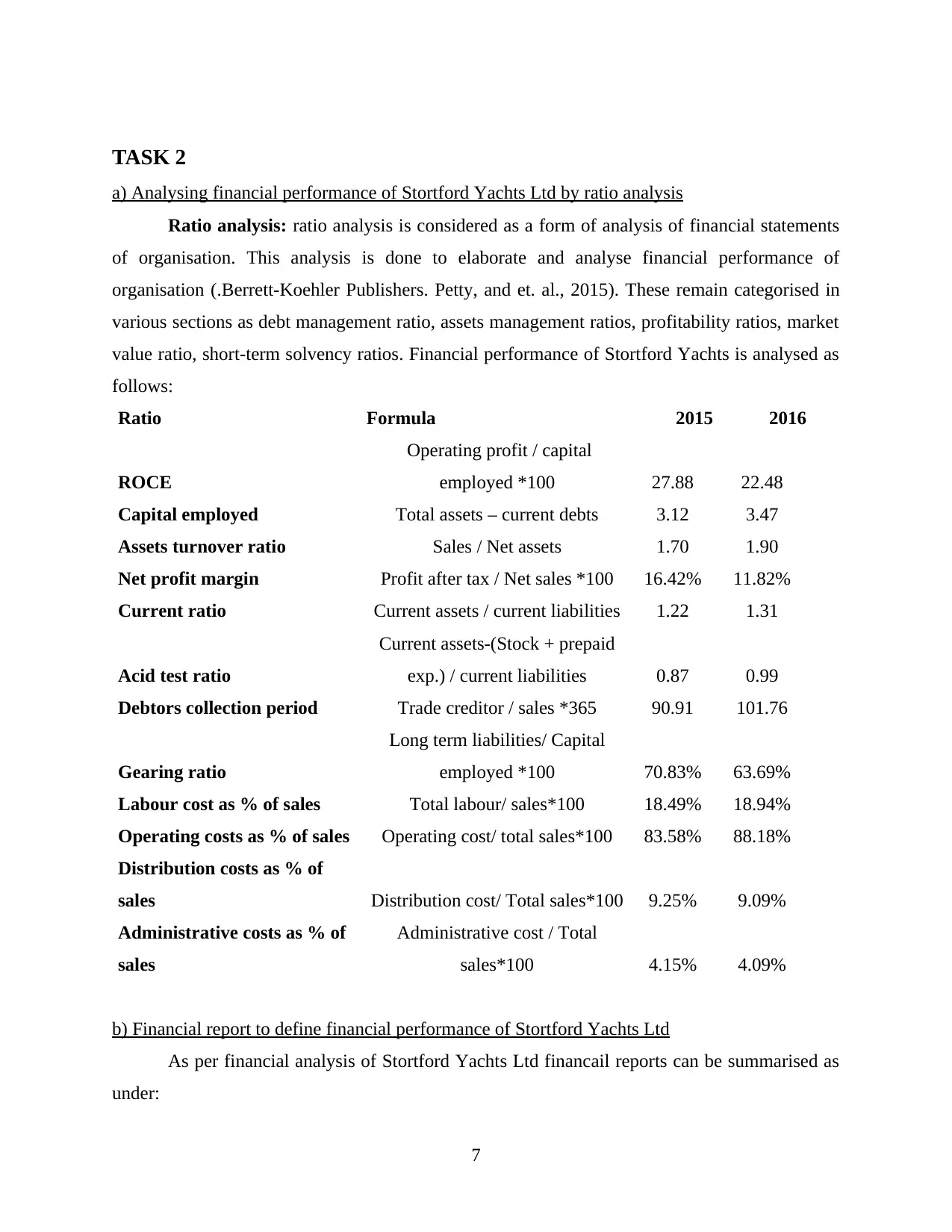
TASK 2
a) Analysing financial performance of Stortford Yachts Ltd by ratio analysis
Ratio analysis: ratio analysis is considered as a form of analysis of financial statements
of organisation. This analysis is done to elaborate and analyse financial performance of
organisation (.Berrett-Koehler Publishers. Petty, and et. al., 2015). These remain categorised in
various sections as debt management ratio, assets management ratios, profitability ratios, market
value ratio, short-term solvency ratios. Financial performance of Stortford Yachts is analysed as
follows:
Ratio Formula 2015 2016
ROCE
Operating profit / capital
employed *100 27.88 22.48
Capital employed Total assets – current debts 3.12 3.47
Assets turnover ratio Sales / Net assets 1.70 1.90
Net profit margin Profit after tax / Net sales *100 16.42% 11.82%
Current ratio Current assets / current liabilities 1.22 1.31
Acid test ratio
Current assets-(Stock + prepaid
exp.) / current liabilities 0.87 0.99
Debtors collection period Trade creditor / sales *365 90.91 101.76
Gearing ratio
Long term liabilities/ Capital
employed *100 70.83% 63.69%
Labour cost as % of sales Total labour/ sales*100 18.49% 18.94%
Operating costs as % of sales Operating cost/ total sales*100 83.58% 88.18%
Distribution costs as % of
sales Distribution cost/ Total sales*100 9.25% 9.09%
Administrative costs as % of
sales
Administrative cost / Total
sales*100 4.15% 4.09%
b) Financial report to define financial performance of Stortford Yachts Ltd
As per financial analysis of Stortford Yachts Ltd financail reports can be summarised as
under:
7
a) Analysing financial performance of Stortford Yachts Ltd by ratio analysis
Ratio analysis: ratio analysis is considered as a form of analysis of financial statements
of organisation. This analysis is done to elaborate and analyse financial performance of
organisation (.Berrett-Koehler Publishers. Petty, and et. al., 2015). These remain categorised in
various sections as debt management ratio, assets management ratios, profitability ratios, market
value ratio, short-term solvency ratios. Financial performance of Stortford Yachts is analysed as
follows:
Ratio Formula 2015 2016
ROCE
Operating profit / capital
employed *100 27.88 22.48
Capital employed Total assets – current debts 3.12 3.47
Assets turnover ratio Sales / Net assets 1.70 1.90
Net profit margin Profit after tax / Net sales *100 16.42% 11.82%
Current ratio Current assets / current liabilities 1.22 1.31
Acid test ratio
Current assets-(Stock + prepaid
exp.) / current liabilities 0.87 0.99
Debtors collection period Trade creditor / sales *365 90.91 101.76
Gearing ratio
Long term liabilities/ Capital
employed *100 70.83% 63.69%
Labour cost as % of sales Total labour/ sales*100 18.49% 18.94%
Operating costs as % of sales Operating cost/ total sales*100 83.58% 88.18%
Distribution costs as % of
sales Distribution cost/ Total sales*100 9.25% 9.09%
Administrative costs as % of
sales
Administrative cost / Total
sales*100 4.15% 4.09%
b) Financial report to define financial performance of Stortford Yachts Ltd
As per financial analysis of Stortford Yachts Ltd financail reports can be summarised as
under:
7
⊘ This is a preview!⊘
Do you want full access?
Subscribe today to unlock all pages.

Trusted by 1+ million students worldwide
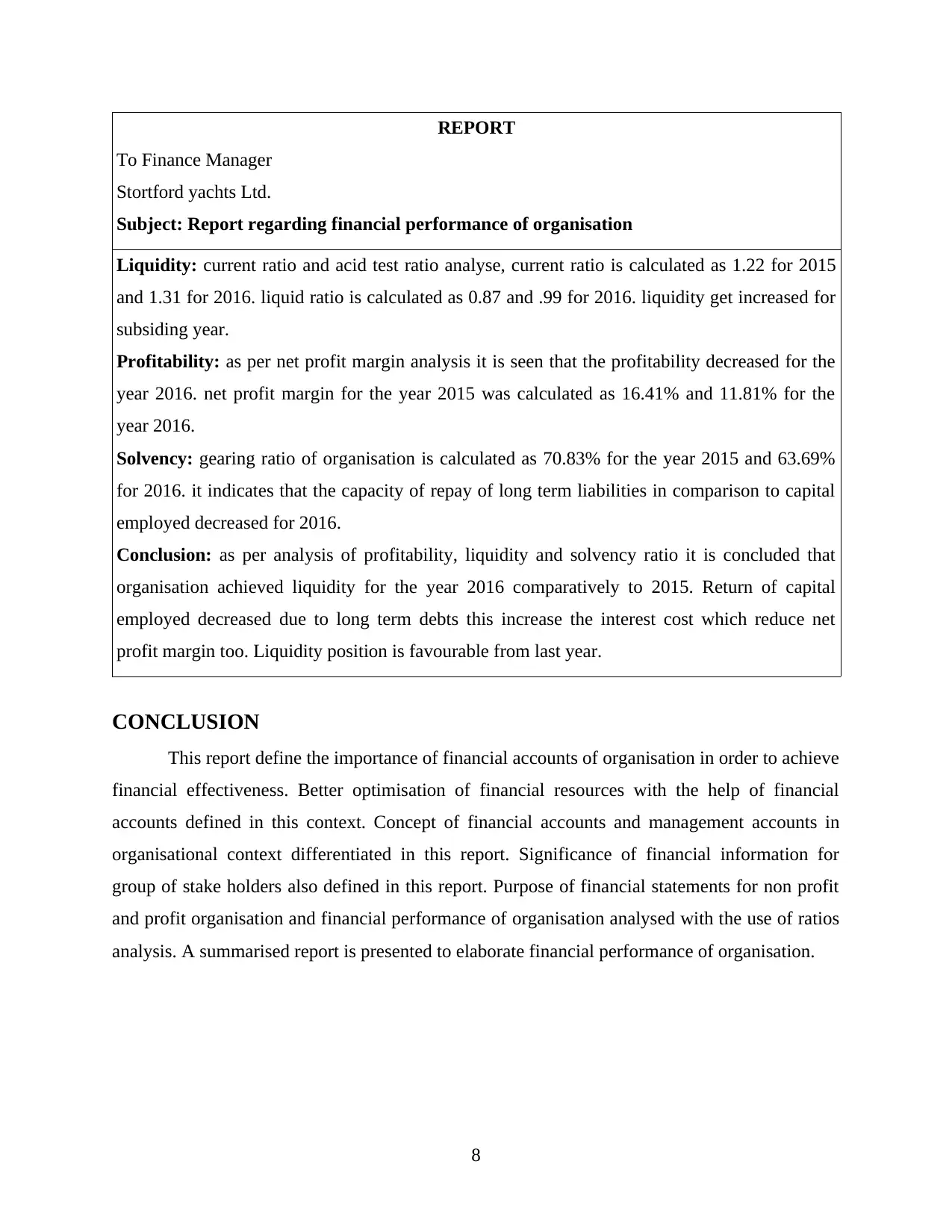
REPORT
To Finance Manager
Stortford yachts Ltd.
Subject: Report regarding financial performance of organisation
Liquidity: current ratio and acid test ratio analyse, current ratio is calculated as 1.22 for 2015
and 1.31 for 2016. liquid ratio is calculated as 0.87 and .99 for 2016. liquidity get increased for
subsiding year.
Profitability: as per net profit margin analysis it is seen that the profitability decreased for the
year 2016. net profit margin for the year 2015 was calculated as 16.41% and 11.81% for the
year 2016.
Solvency: gearing ratio of organisation is calculated as 70.83% for the year 2015 and 63.69%
for 2016. it indicates that the capacity of repay of long term liabilities in comparison to capital
employed decreased for 2016.
Conclusion: as per analysis of profitability, liquidity and solvency ratio it is concluded that
organisation achieved liquidity for the year 2016 comparatively to 2015. Return of capital
employed decreased due to long term debts this increase the interest cost which reduce net
profit margin too. Liquidity position is favourable from last year.
CONCLUSION
This report define the importance of financial accounts of organisation in order to achieve
financial effectiveness. Better optimisation of financial resources with the help of financial
accounts defined in this context. Concept of financial accounts and management accounts in
organisational context differentiated in this report. Significance of financial information for
group of stake holders also defined in this report. Purpose of financial statements for non profit
and profit organisation and financial performance of organisation analysed with the use of ratios
analysis. A summarised report is presented to elaborate financial performance of organisation.
8
To Finance Manager
Stortford yachts Ltd.
Subject: Report regarding financial performance of organisation
Liquidity: current ratio and acid test ratio analyse, current ratio is calculated as 1.22 for 2015
and 1.31 for 2016. liquid ratio is calculated as 0.87 and .99 for 2016. liquidity get increased for
subsiding year.
Profitability: as per net profit margin analysis it is seen that the profitability decreased for the
year 2016. net profit margin for the year 2015 was calculated as 16.41% and 11.81% for the
year 2016.
Solvency: gearing ratio of organisation is calculated as 70.83% for the year 2015 and 63.69%
for 2016. it indicates that the capacity of repay of long term liabilities in comparison to capital
employed decreased for 2016.
Conclusion: as per analysis of profitability, liquidity and solvency ratio it is concluded that
organisation achieved liquidity for the year 2016 comparatively to 2015. Return of capital
employed decreased due to long term debts this increase the interest cost which reduce net
profit margin too. Liquidity position is favourable from last year.
CONCLUSION
This report define the importance of financial accounts of organisation in order to achieve
financial effectiveness. Better optimisation of financial resources with the help of financial
accounts defined in this context. Concept of financial accounts and management accounts in
organisational context differentiated in this report. Significance of financial information for
group of stake holders also defined in this report. Purpose of financial statements for non profit
and profit organisation and financial performance of organisation analysed with the use of ratios
analysis. A summarised report is presented to elaborate financial performance of organisation.
8
Paraphrase This Document
Need a fresh take? Get an instant paraphrase of this document with our AI Paraphraser
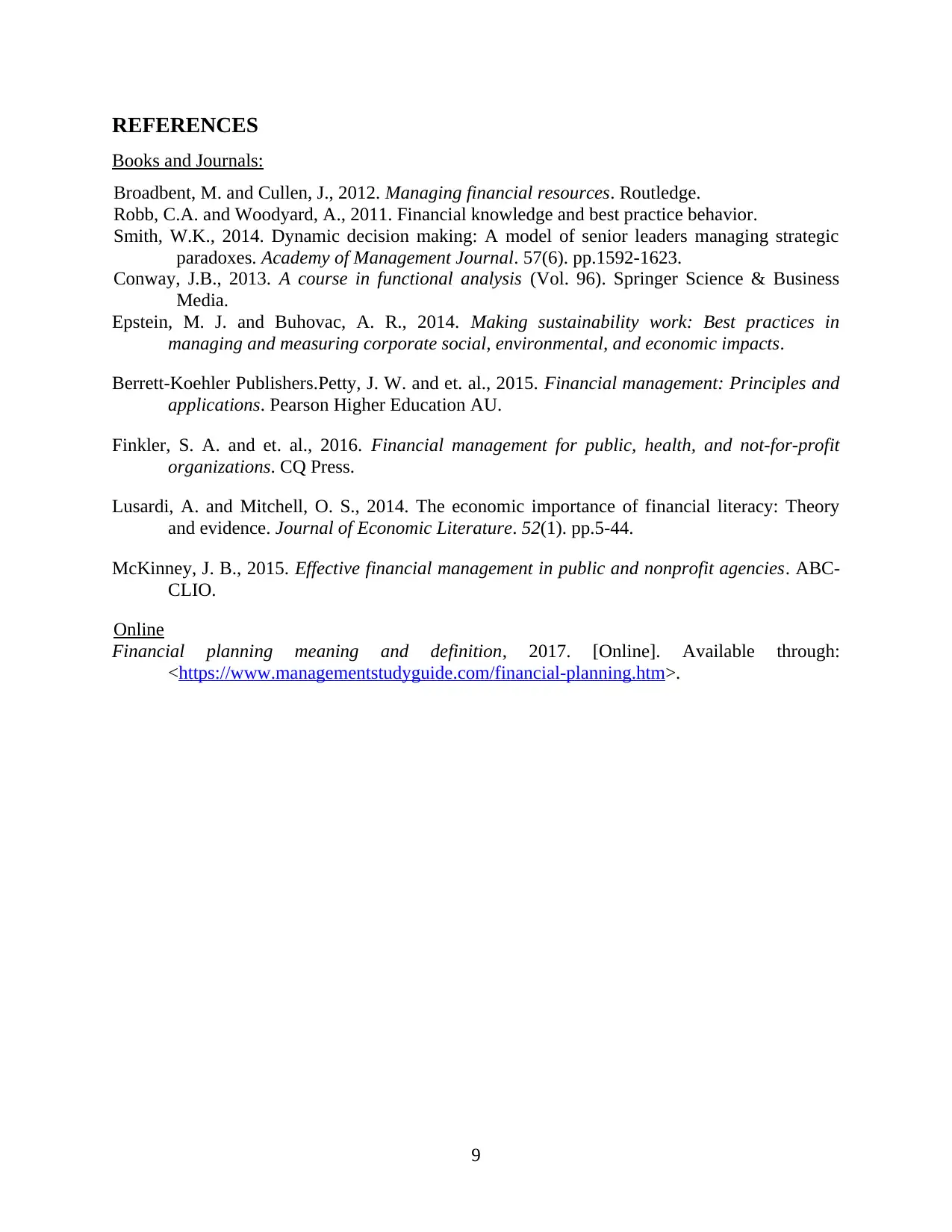
REFERENCES
Books and Journals:
Broadbent, M. and Cullen, J., 2012. Managing financial resources. Routledge.
Robb, C.A. and Woodyard, A., 2011. Financial knowledge and best practice behavior.
Smith, W.K., 2014. Dynamic decision making: A model of senior leaders managing strategic
paradoxes. Academy of Management Journal. 57(6). pp.1592-1623.
Conway, J.B., 2013. A course in functional analysis (Vol. 96). Springer Science & Business
Media.
Epstein, M. J. and Buhovac, A. R., 2014. Making sustainability work: Best practices in
managing and measuring corporate social, environmental, and economic impacts.
Berrett-Koehler Publishers.Petty, J. W. and et. al., 2015. Financial management: Principles and
applications. Pearson Higher Education AU.
Finkler, S. A. and et. al., 2016. Financial management for public, health, and not-for-profit
organizations. CQ Press.
Lusardi, A. and Mitchell, O. S., 2014. The economic importance of financial literacy: Theory
and evidence. Journal of Economic Literature. 52(1). pp.5-44.
McKinney, J. B., 2015. Effective financial management in public and nonprofit agencies. ABC-
CLIO.
Online
Financial planning meaning and definition, 2017. [Online]. Available through:
<https://www.managementstudyguide.com/financial-planning.htm>.
9
Books and Journals:
Broadbent, M. and Cullen, J., 2012. Managing financial resources. Routledge.
Robb, C.A. and Woodyard, A., 2011. Financial knowledge and best practice behavior.
Smith, W.K., 2014. Dynamic decision making: A model of senior leaders managing strategic
paradoxes. Academy of Management Journal. 57(6). pp.1592-1623.
Conway, J.B., 2013. A course in functional analysis (Vol. 96). Springer Science & Business
Media.
Epstein, M. J. and Buhovac, A. R., 2014. Making sustainability work: Best practices in
managing and measuring corporate social, environmental, and economic impacts.
Berrett-Koehler Publishers.Petty, J. W. and et. al., 2015. Financial management: Principles and
applications. Pearson Higher Education AU.
Finkler, S. A. and et. al., 2016. Financial management for public, health, and not-for-profit
organizations. CQ Press.
Lusardi, A. and Mitchell, O. S., 2014. The economic importance of financial literacy: Theory
and evidence. Journal of Economic Literature. 52(1). pp.5-44.
McKinney, J. B., 2015. Effective financial management in public and nonprofit agencies. ABC-
CLIO.
Online
Financial planning meaning and definition, 2017. [Online]. Available through:
<https://www.managementstudyguide.com/financial-planning.htm>.
9
1 out of 11
Related Documents
Your All-in-One AI-Powered Toolkit for Academic Success.
+13062052269
info@desklib.com
Available 24*7 on WhatsApp / Email
![[object Object]](/_next/static/media/star-bottom.7253800d.svg)
Unlock your academic potential
Copyright © 2020–2025 A2Z Services. All Rights Reserved. Developed and managed by ZUCOL.





